“Mee Krob” or “Mee Grob” are crispy rice noodles coated in a sweet and sour sauce. Super addictive with the perfect balance of sweet, tart, and umami, they are popular treats amongst visitors to Thailand. They share many of the same ingredients as Pad Thai, so I like to think of them as crispy pad thai treats! It is often served in squares, so I suppose you can also think of them as savoury "Rice Krispie Treats".
In this post I'll share with you 3 keys to the perfectly crispy, puffed noodles that STAY crispy for weeks! It's not a hard recipe, but it does require precision in order for the noodles to have the right balance of flavours and, most importantly, be the perfect degree of crrrrrrrispy.
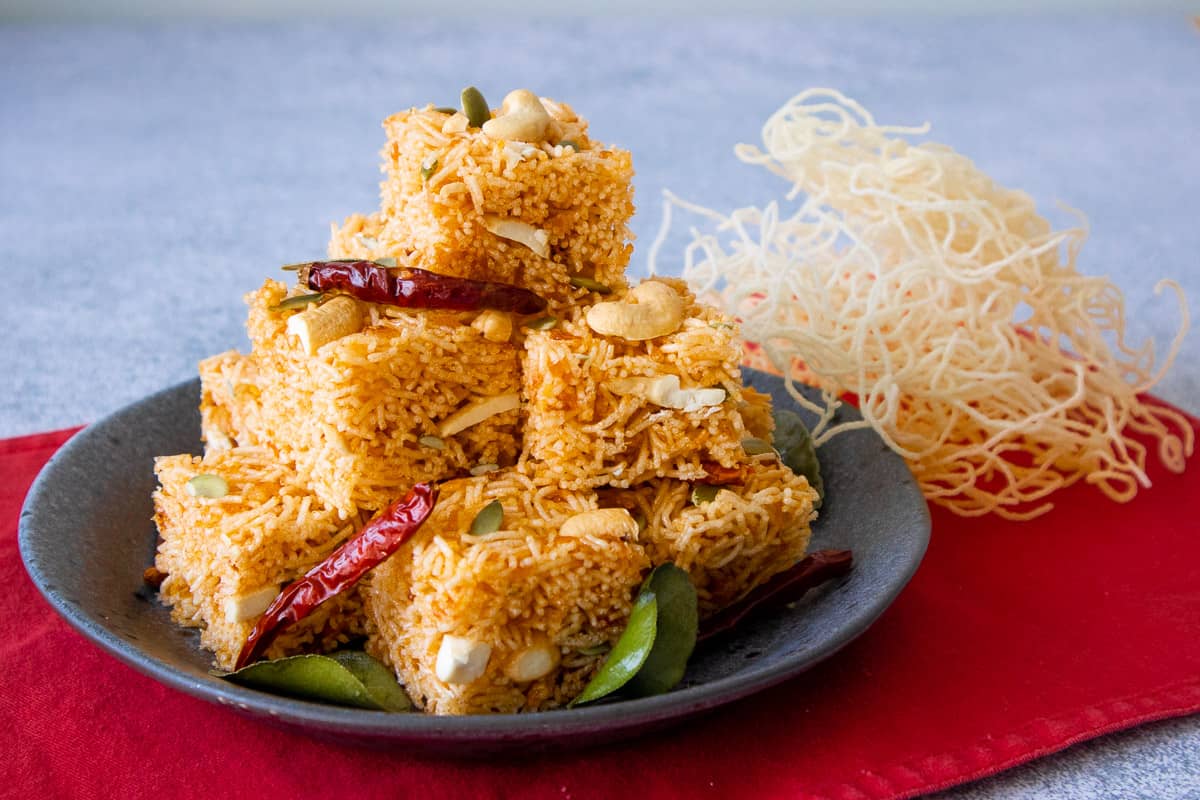
Want to save this recipe?
What You'll Need:
Here are all the ingredients for mee krob. One note: I'm using lime zest, but traditionally, a rare kind of citrus called som sa is used. If you want you can replace the lime zest with orange, lemon, yuzu, or grapefruit zest; or a combination.
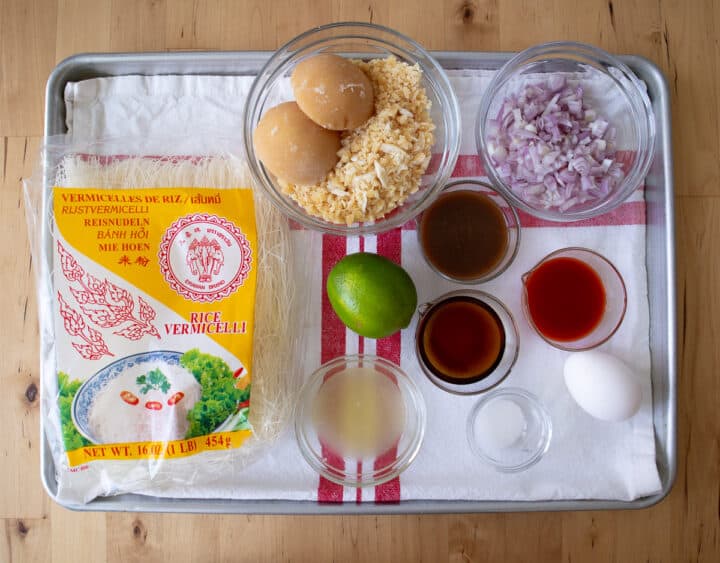
Step-By-Step: How to Make Mee Krob
I highly recommend you check out the full video tutorial in the recipe card below to ensure success, as it really helps to see how the noodles should behave and what the sauce should look like when it's ready. But here's a bird's eye view of what you'll need to do.



3 keys to perfect mee krob that stay crispy
- Weigh Your Ingredients. This is not a recipe you can eyeball, because the ratio of noodles to sauce is everything. Too much noodle and it’ll be bland, and not enough will get you noodles that are overwhelmed with too much sauce; making them too sweet, too sour, too sticky, too ... everything. Not to mention the sauce itself needs to have a good balance of sweet, salty and sour.
So make the recipe exactly as I show you here to start with - you can always tinker with the sauce ratio to better suit your taste next time around. It will not be helpful if you are not precise the first time, because you will have no baseline for modification going forward. - Fry Noodles in HOT oil. I'm talking about 450°F/230°C, or at the very least 430°F/220°C. This is much higher than you’ll ever fry most things, but it is what’s going to get you noodles that are light, crispy, and not oily - as opposed to dense, hard, and oil-clogged.
I highly recommend you watch the video where I show noodles fried at temperatures ranging from 350°F/175°C to 450°F/230°C, so you can see how the noodles SHOULD behave even if you don't have a thermometer. You’ll also see that I’m not kidding that you NEED high temp. (It’s also highly satisfying to watch!)
Try to keep your oil below 475°F /245°C to avoid smoking. The noodles will fry up fine at that temp, but the smoking will deteriorate your oil quality faster than necessary. If it starts to smoke, just turn off the heat and keep frying the noodles with the heat off until the temperature comes down.
On that note, I recommend ventilating your place as much as you can so it doesn't smell like a fast food joint for days! #experience - Cook your sauce until it reaches 240°F/115°C (the soft ball stage in candy making). This is perhaps the most important thing, and it is absolutely key for noodles that STAY crispy.
At this temperature, there is no more moisture (water) left in the sauce, and the sugar is at the stage where it is firm but still pliable when cool. If you do not cook all of the water away, the noodles will turn soggy. But if you cook the sauce for too long, the sugar will harden too much when cooled, which is not what we want either.
So a good instant-read thermometer such as this one that I use is super important for this part. While professional mee krob vendors can go by the way the sauce looks and behaves (very thick with slow, small bubbles), they have a LOT of experience that we don’t have, and it’s definitely not foolproof. Having said that, you can take a look at how the sauce bubbles in the video at 9:20.
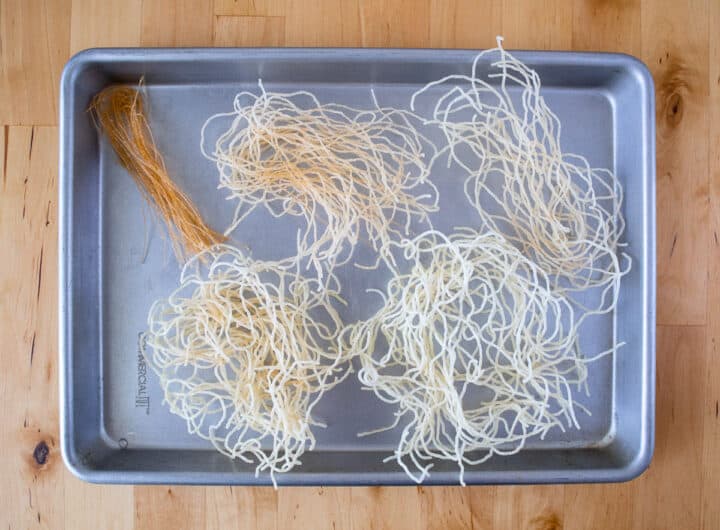
Frequently Asked Questions
Not really! You can make the “meal” kind of mee krob by using these same noodles and stir-frying them with other fresh ingredients and garnishes. I'll have a recipe of that coming up soon, so stay tuned!
While you can fry glass noodles (bean threads) and they will puff up similarly, it’s not quite the same. I have not tried it in this recipe so I can’t say how they will turn out. These thin rice vermicelli are widely available though (and are vegan and gluten-free) so there shouldn’t be a need to substitute.
The thinnest one. They should look like threads, and the ingredients should only be rice and water. To be sure, get ones from Thailand; I use Erawan brand, but Wai Wai brand is also okay to use.
Yes. Instead of fish sauce you can use soy sauce, salt, or vegan fish sauce. To make it vegan you can omit the egg and increase the amount of noodles slightly to make up for the volume (I’d say increase it by 5-10 g, but I have not tested this).
Like any crispy foods, you want to keep these in an airtight container in a dry place to maintain crispiness. You can keep them at room temp, but for places with high humidity, keeping them in the fridge will make them last longer. If you have one of those desiccant packets from another packaged food, throw them into the container as well to help absorb moisture. But let’s face it, they’re not gonna last that long!
I have not tried freezing these but they’ll probably be okay.
Related Recipes
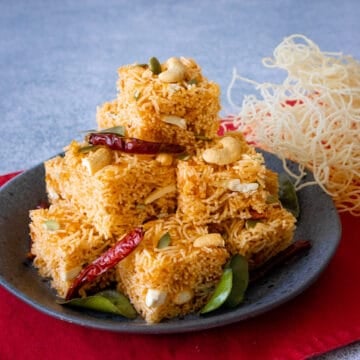
Mee Krob - Sweet & Sour Crispy Noodle Treats
Equipment
- An 8- or 9- inch square pan or casserole dish
Ingredients
The Noodles:
- Oil for frying
- 3.2 oz dry thin rice vermicelli, see note 1
The Sauce:
- ¾ cup shallots, thinly sliced and cut in short pieces
- 2 tablespoon neutral oil
- 1 egg
- 5.3 oz palm sugar, roughly chopped
- 2 tablespoon fish sauce
- ½ teaspoon table salt
- 2 tablespoon tamarind paste
- 2 tablespoon lime juice
- 2 tablespoon Sriracha hot sauce, (see note 2)
- Grated zest of a lime
Optional Add-Ins
- ½ cup roasted cashews, split in half (recommended)
- 2 tablespoon roasted pumpkin seeds
- A handful of fried dried chilies for garnish
- A handful of fried makrut lime leaves for garnish, see note 3
Want to save this recipe?
Notes
- These are the super thread-thin rice vermicelli; not the thicker kind used in Vietnamese spring rolls. Typically two brands are available, "Wai Wai" and "Erawan", make sure they are made in Thailand to be sure it is the right kind.
- I use Thai sriracha (Sriraja Panich brand). If you use the Huy Fong (rooster) brand it will be a little spicier, but still works fine. For less spicy, you can use half ketchup and half sriracha.
- The dried chilies and makrut lime leaves are for garnish, but if you keep them in the mee krob's container for a day or two, the aroma really does infuse into the noodles!
FULL VIDEO TUTORIAL
All my recipes come with step-by-step video tutorials with extra tips not mentioned in the blog post, so make sure you watch the video to ensure success. If you enjoy them, consider subscribing to the YouTube Channel to not miss an episode. Thank you!
Subscribe to my YouTube ChannelInstructions
For the noodles:
- In a wok or a pot over high heat, add at least 1 ½ inches of frying oil, but leave at least 2 inches of room in the pot to accommodate puffing noodles. If you're also frying the chilies and makrut lime leaves for garnish, heat the oil first to 325°F/160°C. If only frying noodles, heat it to 450°F/230°C. Prepare a large mixing bowl or baking sheet lined with paper towel to put the noodles into after frying.Oil for frying
- While the oil heats, pull the rice noodles apart into small bundles, then cut them in half with scissors. The smaller your frying vessel, the smaller the bundles need to be so they have room to expand. (Best to see the video for this part so you know how big the should be and how much they puff up.)3.2 oz dry thin rice vermicelli
- If you’re frying makrut lime leaves and dried chilies, make sure they are DRY, and once the oil reaches 325°F/160°C, fry the lime leaves until they stop bubbling, this takes only several seconds. *They may bubble aggressively so stand back a bit. Remove and drain on paper towel. Then fry the dried chilies just until they darken slightly, this also takes only a few seconds. Drain on paper towel.A handful of fried makrut lime leaves for garnish, A handful of fried dried chilies for garnish
- Once the oil reaches 450°F/230°C, turn the heat down to medium to medium-low and add a small bundle of noodles into the oil; it should puff up immediately into fluffy, airy white noodles. As it puffs up, push the middle down slightly to make sure that everything has had a chance to completely fry. Once the noodles are puffed (this takes literally 2 seconds) remove with a slotted skimmer or tongs, shake off excess oil, and place it in the prepared mixing bowl. Repeat with the remaining noodles. *Make sure the noodles always puff up immediately; if they’re getting slower, the oil temp has dropped too much. If the oil smokes, it's getting too hot; turn off the heat and fry a few bundles of the noodles with the heat off which will help drop the temp more quickly.
For the sauce:
- Before you start the sauce, first prepare your mold which can be a cake pan, a casserole dish, or any kind of containers to shape the noodles. This recipe fits a 9-inch square pan perfectly, but you can use multiple containers or even half-fill a bigger pan. Line the bottom of the pan with parchment or foil to help it come out more easily, though this is not necessary as you can cut them right in the pan.
- In a large non-reactive wok or skillet, saute the shallots in the oil over medium low heat until soft and caramelized, 5-6 minutes.*Ideally you want to use a large non-reactive wok (so not carbon steel or cast iron) so you can mix the noodles right in there. If you don't have it, you can make the sauce in a stainless steel skillet, and then toss it with the noodles in a large mixing bowl.¾ cup shallots, 2 tablespoon neutral oil
- Once the shallots are done, add the egg and scramble into tiny pieces.1 egg
- Add the palm sugar, fish sauce, salt, tamarind, sriracha, lime juice and lime zest; keep cooking on medium low heat, stirring constantly, until it reaches a temperature of 240°F/115°C. I do not recommend you eyeball this; use a thermometer to be sure otherwise your noodles might not stay crispy after tossing with the sauce. See post above for more details.5.3 oz palm sugar, 2 tablespoon fish sauce, ½ teaspoon table salt, 2 tablespoon tamarind paste, 2 tablespoon lime juice, 2 tablespoon Sriracha hot sauce, Grated zest of a lime
- Once the sauce is ready, turn the heat down to the lowest heat and add all of the noodles to the wok. Crush the noodles down so that they will fit into the wok, then use 2 spatulas to quickly but thoroughly toss the noodles with the sauce until they are evenly coated. If the pan you're using for the sauce is not big enough, drizzle the sauce over the noodles in a large mixing bowl, then toss.*IMPORTANT: Keep an eye out for any clumps of sauce and break it apart. These clumps will end up being overpowering bits that are too sweet, and it will take away sauce from the other parts of the noodles. This is another reason why ideally you want to toss noodles in the wok, so we can keep the heat on for a bit to keep the sauce from stiffening as it cools, making it easier to mix.
- While still warm, put half of the noodles into the parchment-lined square cake pan or casserole dish and spread it out to fill the pan evenly. Sprinkle half of the cashews and pumpkin seeds over, if using, then spread the remaining noodles on top, followed by the remaining cashews and pumpkin seeds. Then use a measuring cup with a flat bottom to push the noodles down to pack them so they will hold together when cut, but without crushing the noodles.½ cup roasted cashews, 2 tablespoon roasted pumpkin seeds
- Let cool completely, then either cut it in the pan or unmold it and cut it on a cutting board. Keep the pieces in an airtight container along with fried lime leaves and chilies, if desired. You can enjoy them now, but if possible wait at least half a day before serving to allow the flavours to settle into the noodles. You can eat the fried chilies if you like it spicy, but do not eat the dried lime leaves, they're just for aroma and garnish!
- Storage: They will keep for at least a week in an airtight container at room temperature. Put them in the fridge if you're in a humid climate. See FAQ above for more details.

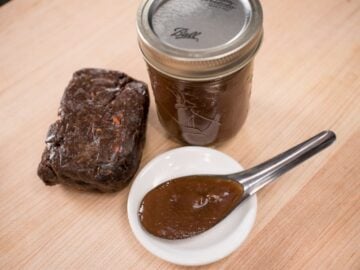
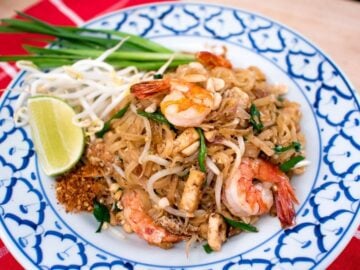
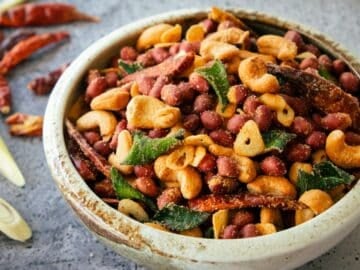

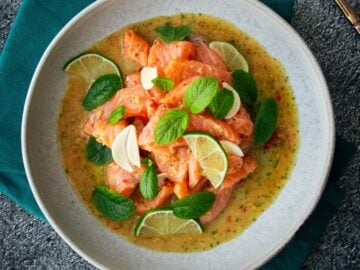
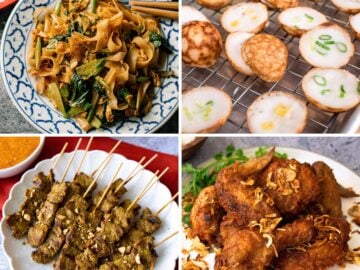
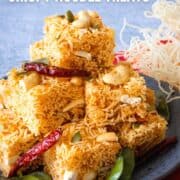
TLA says
I made these but my final noodles remained soft not crispy. I used a thermometer for the sauce temperature, what else could be wrong? Flavours are excellent.
Pailin Chongchitnant says
Were the noodles crispy before you mixed them with the sauce? If so, the only thing that can cause this is is there was too much moisture either left in the sauce, or if you introduced other ingredients that contained moisture.
Sally says
I fell in love with these when I found them at Trader Joe's. They discontinued them so I went online in search of a recipe to make my own and found this recipe. I used a mise en place technique so I wouldn't forget anything the first time. But I had the salt off to the side. Your instructions don't say anything about adding the salt so I forgot it. But it was still excellent. I had to break into it right away to taste because I couldn't wait 1/2 day for the flavors to meld, LOL. My other mistake was I didn't see that I was only using 3.2 oz of the noodles and I fried the whole batch. Now I have a lot of leftover noodles to use for future batches. I'm storing in a big bag with dessicant packets to keep them crispy. I'm sure I won't have any trouble using them up! Thanks for the yummy recipe, just the salt into the instructions.
Pailin Chongchitnant says
Ah, apologies about the salt! It's been added, thank you!
Mike D, says
Hi, Pai. Full disclosure, I haven't exactly made your recipe yet, but I made one from Lion Brand Rice (Google those words plus "mee krob") that's very similar. I probably would've been happy enough with that one, but the noodles didn't fry up right so I went looking for other recipes, and that's how I found yours. And you saved me in the eyes of my wife and niece!
Want to know what temperature they specified for frying the noodles? 180C, which is 356F, which I thought was way too low. (But it's been some years since I last fried rice noodles, so I went with it.) Well, you know what happened, because your picture above shows a trial at 350: hard and brown. Then I went to 370, 380, & 390 (I had 4 squares to fry), and my 390 batch was similar to your 400, but worse of course.
So I went back, heated the oil to a solid 450, and BAM, the noodles puffed up just like I remembered, and like the Lion Brand video showed. (By the way, I went to your Youtube channel and couldn't find Mee Krob. Is it still there and I just missed it?)
And I saw egg in your recipe and thought, "Huh." But I scrambled one and stirred it into my leftover sauce and WOW, what a difference that makes!
One last thing before I let you go: I eat Rice Krispie Treats straight from the pan at least once a week, and while I was stirring up my first batch in the wok I told my wife that it was like "savory Rice Krispie treats." My exact words, I swear. And then I saw you said that right in your first paragraph! I showed my wife and said, "Told ya!"
Anyway, I'm going to go order one of your books now!
Take care,
Mike in Atlanta
Pailin Chongchitnant says
Hi Mike, thanks so much for this story! I'm glad I was able to help demystify noodle frying!! As a rule of thumb, I never trust recipes by Asian product companies. You'd think they'd have reliable recipes cuz after all it would reflect badly on their products, but in my experience it looks like they just put something there just to have it. They are rarely reliable and often wrong. Not like the Nestle Tollhouse Cookie recipe, lol! Thanks in advance for the cookbook purchase! And the video is still on YouTube but I may have named it differently...I think I spelled it Mee Grob.
Mike says
Pai,
Thank you for replying to me. I know you're busy, but it means a lot. I just made your recipe to a T (except for Sriracha half-and-and with ketchup), and it's officially the bomb! (Oh, I didn't have pine nuts, but did use cashews.) My wife is on her third plate (I didn't mold it), and she keeps saying, "This is SO good!" Our 20yo niece loves it too, and even our little Shih Tzu is sitting here begging it from me.
I found the recipe on Youtube, under Mee Krob, don't know why I couldn't find it before. I see now that you used less lime zest than that of a whole lime, which is what I read that as. That's the only thing I'd change, though, this is just SO good!
You've been an inspiration to me and gotten me back into trying to perfect my Pad Thai, and it's pretty close right now. I made your "Leftover Fried Rice" the other day and it got great reviews. Oh, and your Massaman Curry Chicken (from a tub of paste I had. I bought Hot Thai Kitchen, and after I've learned from that I'll get Sabai. Thank you for making Thai cooking so accessible to us Westerners!
Pailin Chongchitnant says
Thanks so much for the report Mike! So glad to hear it was a success. And well done to you as this is not an easy recipe! Thank you for buying my book as well, I hope you will enjoy them!
Rachel says
This recipe is excellent. I made it for a party, and the guests who had never had anything like it before polished off the entire plate and asked if I had any more.
You rarely see Mee Krob on the menus in the U.S. My mother was a fan of it, so we when she found a restaurant that served it she introduced me to it. It was our staple to order every time we went to visit. Sadly, we moved away and 30 years later I've never found another Thai restaurant that serves it. The flavors took me right back and I will share it with her as soon as I can see her again.
I can't believe this doesn't have more reviews!
Pailin Chongchitnant says
Thank you so much! I am so glad to hear this lived up to your memory of it. And that happened to me when I served it to people who never had anything like it before...they polished it off!
Ruth says
Hello Phai I have been looking for palm sugar in Asian grocery stores in my city and in one of them I found this brand:
https://shopee.co.th/%E0%B8%99%E0%B9%89%E0%B8%B3%E0%B8%95%E0%B8%B2%E0%B8%A5%E0%B8%A1%E0%B8%B0%E0%B8%9E%E0%B8%A3%E0%B9%89%E0%B8%B2%E0%B8%A7(%E0%B8%95%E0%B8%A3%E0%B8%B2-%E0%B8%9A%E0%B9%89%E0%B8%B2%E0%B8%99%E0%B8%95%E0%B8%B2%E0%B8%A5%E0%B8%9B%E0%B8%B6%E0%B8%81)-1kg-COCONUT-SUGAR-1KG-i.57636560.935526390
But since it says "coconut sugar" on the packaging, I don't know if it's the palm sugar that you use in recipes?
Pailin Chongchitnant says
Yes that is the same one.
Em says
First attempt wasnt perfect with the noodles but the taste is great! I love ordering Crispy Pad Thai and wanted to figure out how it was made! Great Recipie!